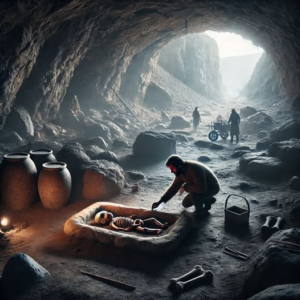An extraordinary find in southern Italy reveals what early humans were like! In a cave known as Grotta delle Mura, located in Monopoli, Puglia, scientists discovered in 1998 the remains of a child who lived between 16,910 and 17,320 years ago. This little one, nicknamed the ‘Grotta delle Mura baby’, is now considered the oldest blue-eyed person ever found.
🕰 Period in which he lived
The boy inhabited the Earth shortly after the last glacial maximum, a period when glaciers covered approximately 25% of the Earth’s surface. This discovery offers us a unique window into life during the Ice Age.
💟 Physical appearance
Genetic analysis revealed fascinating features of its appearance:
- Dark skin, darker than that of modern Europeans.
- Pale blue eyes, a common trait among Western European hunter-gatherers of that time.
- Dark and curly hair.
👶 Height and age
The child was about 76 centimeters tall at the time of his death and was between 7.5 and 18 months old.
Health and causes of death:
Detailed analysis of the skeleton revealed that she suffered from familial hypertrophic cardiomyopathy, an inherited disease that affects the heart. In addition, marks on her teeth suggest that her mother may have experienced physiological stress and malnutrition during pregnancy. To make matters worse, a fractured collarbone indicates that the birth was particularly difficult.
Importance of the discovery:
Scientists managed to recover 75% of his genome, an extraordinary achievement considering the age of the remains. This child is linked to the “Villabruna cluster,” a population that inhabited Europe approximately 14,000 years ago. This suggests that the origins of this population began in southern Europe during the Ice Age.
Community life:
Despite the adversities, scientists believe that the child’s mother lived in a close and stable community, where she participated in daily activities such as food gathering. This indicates that human communities of that time had an organized and cooperative social structure.
A look back:
This discovery not only reveals what life was like during the last Ice Age, but also what early humans looked like and were in good health. It also provides a key piece of information for understanding the evolution of human populations in Europe and their adaptations to extreme climates.
🌍 This extraordinary discovery remains a source of wonder for scientists, reminding us how much there is still to learn about our ancestors.







